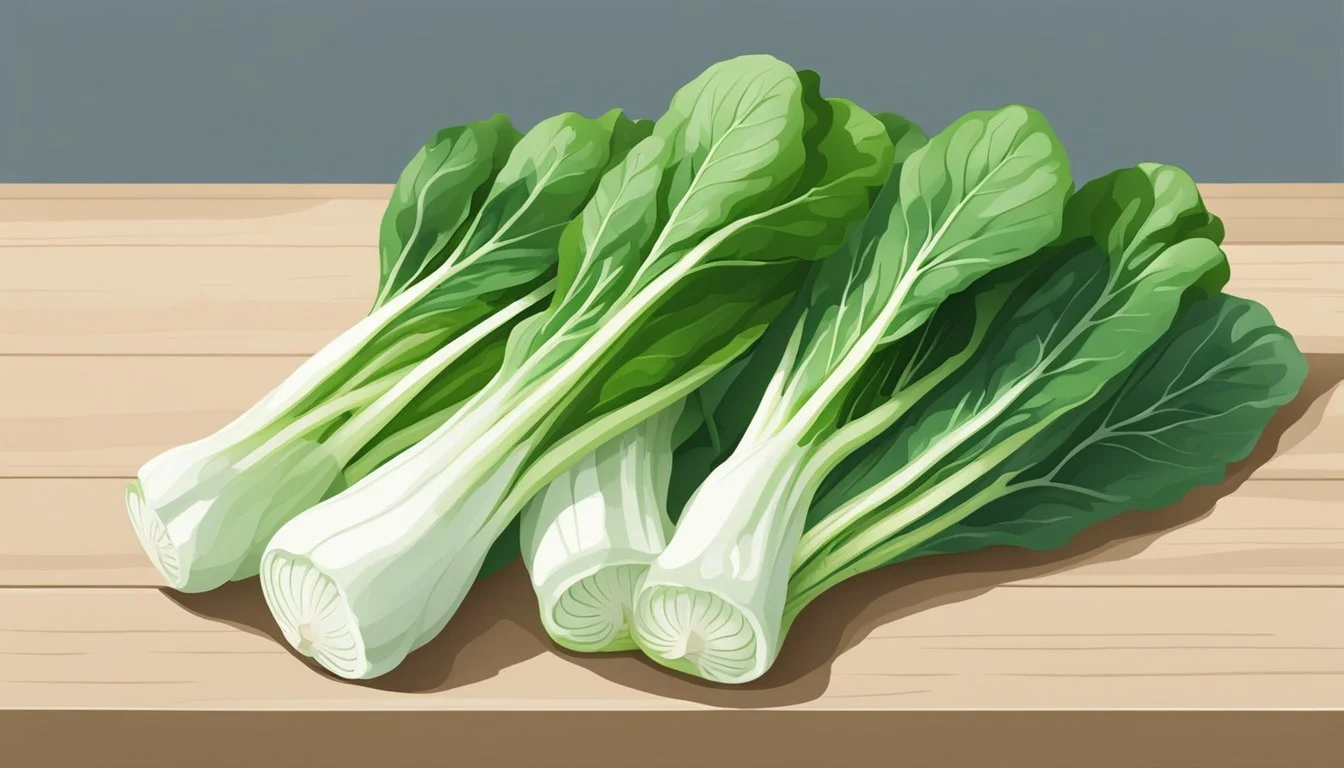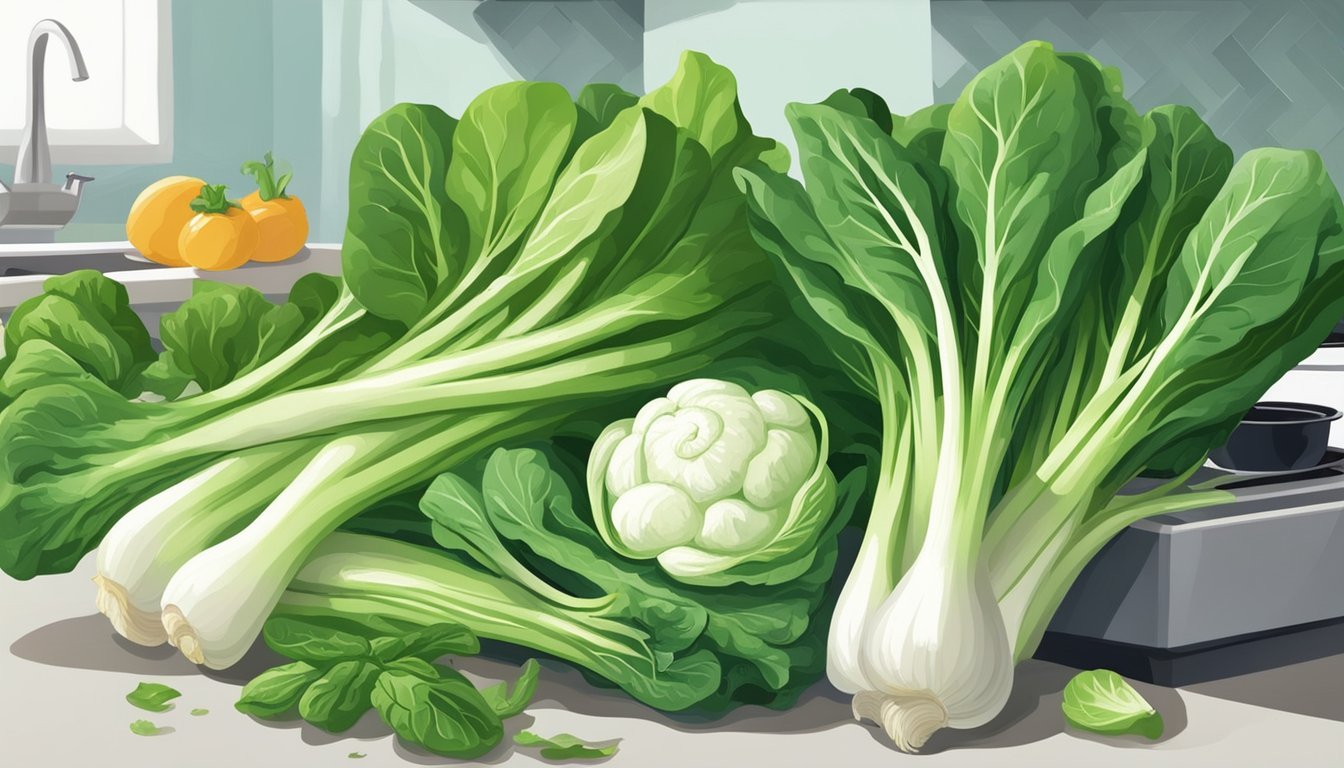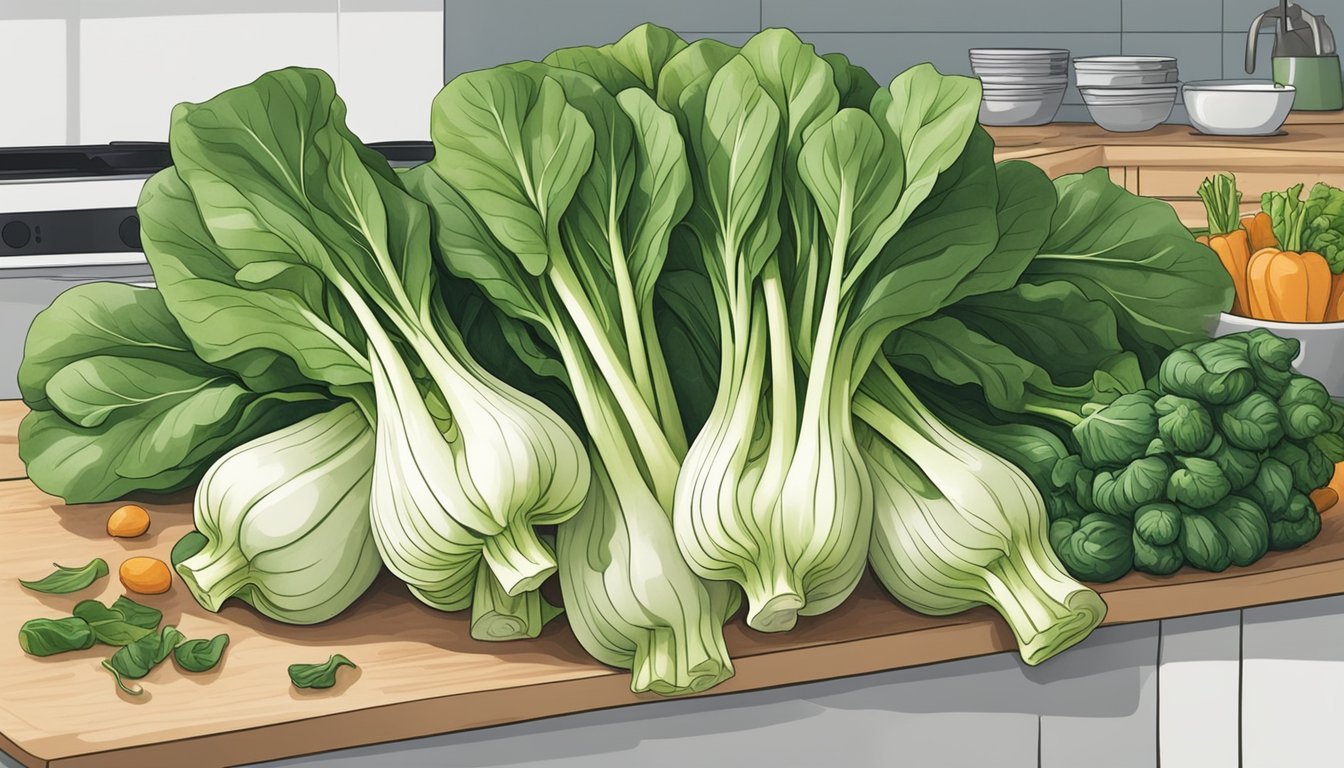How Long Does Bok Choy Last?
Shelf Life and Storage Tips
Bok choy, a staple in Asian cooking, is a leafy green vegetable known for its versatility and nutritional value. Understanding its shelf life is essential for maintaining its freshness and ensuring the best quality in meal preparation. Shelf life can vary depending on a number of factors including initial freshness, storage conditions, and whether the bok choy is cooked or raw.
In its raw state, bok choy can last between one to two weeks when properly stored in the refrigerator. To achieve this shelf life, it should be rinsed under cold water, patted dry to remove excess moisture, and wrapped in a damp paper towel to maintain humidity before being placed in a plastic bag in the crisper drawer. Maintaining the correct environment in the fridge is critical for prolonging the freshness of this vegetable.
When bok choy is cooked, its shelf life decreases, and it will typically last for up to five days when stored in an airtight container in the refrigerator. Freezing is also an option for extending the shelf life of bok choy, especially when larger quantities are involved, although it may alter the texture of the vegetable. For the best results in preserving its quality, blanching bok choy before freezing is recommended.
Identifying Fresh Bok Choy
Selecting fresh bok choy is crucial for both taste and nutritional value. One can judge the freshness through careful observation of appearance, texture, and color, and by noting any signs of spoilage.
Appearance and Texture
Fresh bok choy should have firm white stalks that hold their shape when lightly squeezed. The leaves at the ends should not be limp but rather crisp, indicating freshness. The feel of the bok choy should be solid and plump, with no soft spots which can suggest the beginning of decay.
Color and Signs of Spoilage
The ideal color of fresh bok choy is deep green for its leaves and a bright white for its stalks. Any yellowing of the leaves or brown spots can be an indication of age or poor storage. Wilted leaves are another sign that the bok choy is past its prime. Fresh bok choy should show no signs of spoilage; if it emits an unpleasant odor or has a slimy texture, it should be discarded.
Optimal Storage Methods
Proper storage techniques are crucial for extending the longevity of bok choy. Adhering to the best refrigeration and freezing methods ensures the vegetable retains its quality and nutritional value for as long as possible.
Refrigeration Techniques
When storing bok choy in the refrigerator, one should first wrap the vegetable completely in a paper towel to absorb excess moisture. It can then be placed in a plastic bag, ensuring that all sides are fully covered. For enhanced freshness, the ideal location in the refrigerator is the vegetable crisper or crisper drawer, where the temperature is more consistent. Some prefer using a perforated plastic bag to allow for adequate air circulation, which can also help keep bok choy fresh.
Do
Wrap bok choy in a paper towel.
Place in a plastic bag or perforated plastic bag.
Store in the crisper drawer of the refrigerator.
Don't
Leave it unwrapped or uncontained.
Store in excessively cold or warm parts of the fridge.
Freezing Procedures
For long-term storage, bok choy can be preserved in the freezer. Initially, one should rinse the leaves and stalks to remove any dirt and pat them dry. Flash freezing on a baking sheet prevents the leaves from clumping together. After they are partially frozen, transfer the bok choy to an airtight container or a Ziploc freezer bag. It is also important to remove as much air as possible from the bag to minimize freezer burn.
Do
Clean and dry bok choy before freezing.
Flash freeze on a baking sheet.
Transfer to an airtight container or freezer bag, squeezing out excess air.
Don't
Freeze bok choy without first flash freezing.
Leave air in the freezer bag which can cause freezer burn.
Extending Shelf Life
Proper preparation and storage techniques are essential for extending the shelf life of bok choy. These methods slow the degradation process, ensuring that bok choy remains crisp and nutritious for a longer period.
Wash and Prep Techniques
When storing bok choy, one begins by thoroughly washing the leaves to remove any dirt or debris. After washing, it is crucial to dry the bok choy completely to prevent mold growth. For optimal storage, bok choy should be wrapped lightly in a paper towel to absorb any excess moisture and then placed in an airtight container or plastic bag before refrigerating. The paper towel serves to wick away moisture, while the container or bag keeps out excess air that can accelerate decay.
Blanching Before Freezing
Blanching bok choy prior to freezing is a proven method to preserve its quality. Here's a concise guide on how to blanch:
Boil water in a large pot.
Prepare bok choy by separating leaves, washing, and then cutting into evenly sized pieces.
Submerge bok choy in boiling water for 1-2 minutes.
Immediately transfer bok choy to a bowl of ice water to halt the cooking process.
Drain the bok choy and pat dry thoroughly.
Spread out on a baking sheet to flash freeze.
Once partially frozen, place bok choy in freezer bags, pressing out as much air as possible before sealing.
Blanching deactivates enzymes that cause decay, and flash freezing prevents the bok choy pieces from sticking together. Freezing in airtight containers or sealed freezer bags can keep bok choy fresh for up to 10-12 months. It's essential that the bags are devoid of air to avoid freezer burn and to maximize longevity.
Preparing Bok Choy for Consumption
Proper preparation of bok choy is essential whether it's to be cooked or used fresh in a salad. Knowing the best ways to prepare bok choy can significantly enhance its flavor and preserve its crisp texture.
Cooking Tips
Before cooking, bok choy should be washed thoroughly to remove dirt trapped between the leaves. Here are the steps to prepare bok choy for cooking:
Separate the leaves from the stem for a thorough cleaning.
Rinse under cold, running water.
Shake off excess water and pat dry with a clean towel.
For cooking, bok choy can be boiled, steamed, or sautéed. When steaming, heat water in a pot to a simmer and place bok choy in a steamer basket above the water. If using just the leaves, steam for 3 to 4 minutes until bright green. Cooking times may vary depending on whether one is using mature bok choy or the more tender baby bok choy.
In stir-fries, heat oil in a pan over medium-high heat, and start by sautéing aromatics like garlic and ginger. Once fragrant, add the bok choy and quickly stir-fry it, incorporating soy sauce or other seasonings for flavor.
Salad Preparation
For use in salads, crisp, fresh bok choy provides a crunchy and nutritious addition. To prepare:
Cut bok choy into thin strips suitable for a salad.
Ensure the leaves are completely dry after washing to avoid a soggy salad.
If desired, one can blanch the bok choy quickly in boiling water to enhance the texture before cooling and adding it to the salad. This step is optional and more commonly used for mature bok choy, not baby bok choy.
Combining bok choy in salads with complementary dressings and ingredients can bring out its subtle flavor, making it a fresh, vibrant component of the dish.
Recognizing Spoilage
Identifying when bok choy has gone bad is crucial to ensure food safety and quality. This part of the article focuses on the clear signs of deterioration and the conditions that necessitate discarding bok choy.
Signs of Deterioration
The freshness of bok choy can deteriorate due to various factors, with visible signs indicating spoilage:
Wilting: The leaves may become limp and lose their firmness.
Discoloration: Yellowing or browning of the leaves is a notable change.
Dirt and Debris: Presence of excessive dirt can contribute to spoilage.
Soft Spots and Texture: A slimy texture or mushy areas signify spoilage.
Odor: An off smell is a definite sign of spoiled bok choy.
When to Discard Bok Choy
Bok choy should be discarded in the following circumstances:
Presence of Mold: If any mold is visible, it is advisable to throw away the entire vegetable.
Intense Discoloration: Extensive yellow or brown spots indicate that the vegetable is no longer fresh.
Prolonged Storage: If bok choy has been stored for longer than 5 days in the refrigerator, inspect it thoroughly before use.
Off Odor or Taste: Any uncharacteristic odor or flavor is a clear indication that bok choy is not suitable for consumption.
Bok Choy Varieties and Selection
When selecting bok choy, a shopper encounters a variety of types and must determine freshness for the best quality. This involves understanding the different types of bok choy available and the key indicators of freshness at the store.
Different Types of Bok Choy
There are several types of bok choy that a customer may find at a grocery store or farmers market. The most common type is white bok choy, known for its crisp white stems and dark green crinkly leaves. Another popular variety is baby bok choy, which is smaller with tender leaves and a sweeter taste. Pak choi is a term that often refers to bok choy and can be used interchangeably.
The main differences between these types are size and flavor, with baby bok choy being more delicate and suitable for quick cooking methods such as sautéing. White bok choy, being larger, can withstand longer cooking times and is often found in soups and stews.
Choosing Fresh Bok Choy at the Store
When buying bok choy, freshness is paramount. Here's what shoppers should look for:
Stems: They should be firm and white without any brown spots or signs of wilting.
Leaves: Look for dark green leaves; they are indicative of freshness. The leaves should not be limp or yellowing.
Texture: The leaves and stems should have a crisp texture.
To ascertain freshness, one might also gently squeeze the stem to ensure it is not soft or rubbery, which can be a sign of older bok choy. Lastly, always inspect the base where it was cut from the ground; a clean cut usually means it has been harvested more recently.
Nutritional Information and Benefits
Bok choy stands out as a nutrient-dense leafy green vegetable, contributing a wealth of vitamins and minerals to one's diet while also offering numerous health benefits due to its fiber content and status as a cruciferous vegetable.
Vitamins and Minerals
Bok choy is particularly rich in essential vitamins such as Vitamin A and Vitamin C. It offers substantial amounts of Vitamin K and calcium, crucial for bone health. Here’s a closer look:
Vitamin A: Essential for eye health and immune function, bok choy provides about 17% of the Daily Value (DV).
Vitamin C: A potent antioxidant, essential for the growth and repair of tissues, accounting for up to 50% of the DV per 100 grams.
Vitamin K: Beneficial for blood clotting and bone metabolism, with 27% of the DV in bok choy.
Calcium: Important for bone health and proper function of the heart, muscles, and nerves.
Dietary Fiber and Health Advantages
Bok choy has a good fiber content which supports digestive health. As a cruciferous vegetable, it contains compounds that may provide health benefits such as:
Regulation of Blood Sugar: The fiber in bok choy can slow sugar absorption.
Cardiovascular Health: Bok choy's nutrients may contribute to maintaining healthy blood pressure and cholesterol levels.
Anti-Inflammatory Properties: Compounds found in bok choy may help reduce inflammation, a marker associated with various chronic diseases.
Frequently Asked Questions
Proper storage techniques can significantly extend the shelf life of bok choy. This section covers essential details on how long bok choy lasts under refrigeration and when frozen.
Storage Duration
Bok choy can remain fresh for different lengths of time depending on how it is stored:
In the Refrigerator: Bok choy typically lasts 1-2 weeks when stored correctly in the refrigerator. It should be rinsed, patted dry, wrapped in a damp towel, and placed in a plastic bag in the crisper drawer.
In the Freezer: When properly frozen, bok choy maintains its quality for about 12 months. To freeze bok choy, blanching it first is recommended to preserve flavor and texture.
Refrigeration vs. Freezing
Refrigerated bok choy should be stored as follows:
Rinse the bok choy thoroughly to remove dirt.
Dry it with a clean towel.
Wrap in a damp paper towel.
Place inside a plastic bag and store in the vegetable drawer.
For freezing bok choy:
Blanch in boiling water for two minutes and then immerse in ice water.
Dry the leaves thoroughly.
Pack the bok choy in airtight freezer bags.
Freeze at 0°F or lower.
While refrigeration can keep bok choy fresh for up to two weeks, freezing extends its shelf life up to a year without compromising safety, although the best quality is maintained within the first 12 months.
Environmental Considerations
When it comes to preserving the freshness of bok choy, various environmental factors play a critical role. Understanding these can help in extending the vegetable's shelf life and reducing food waste.
Ethylene and Other Factors
Bok choy, like many leafy greens, is sensitive to ethylene, a natural gas released by certain fruits and vegetables. Ethylene can accelerate the ripening and subsequent spoilage of sensitive produce. Therefore, storing bok choy away from ethylene-producing items such as apples and bananas is essential. Temperature also significantly impacts bok choy's longevity; it should be kept in a vegetable crisper in the refrigerator, where the cooler and more consistent temperatures slow down decay.
Reducing Food Waste
Proper storage of bok choy not only preserves its quality but also contributes to reducing food waste. Storing bok choy correctly in the fridge increases its shelf life to 5-7 days, and potentially up to two weeks. To achieve this, one should:
Rinse bok choy under cold water.
Pat dry with a clean towel.
Wrap in a damp towel or paper towel.
Place it in a plastic bag or storage container.
Store in the vegetable crisper of the refrigerator.
By following these steps, consumers ensure that bok choy remains fresh for as long as possible, helping to minimize the amount of food that goes uneaten and thrown away.










